Wave Optics | Physics - Short Answer Questions | 12th Physics : UNIT 7 : Wave Optics
Chapter: 12th Physics : UNIT 7 : Wave Optics
Short Answer Questions
Short Answer Questions
1. What are the salient features of corpuscular theory of light?
1)
According to Corpuscular theory, light is emitted as tiny, massless and perfectly elastic particles called corpuscles.
2)
As the corpuscles are very small, the
source of light does not suffer
appreciable loss of mass even if
it emits light for a long time.
3)
On account of high speed, they are unaffected
by the force of gravity and their path is a straight line in a medium of uniform refractive index.
4)
The energy of light is the kinetic
energy of these corpuscles.
5)
When these corpuscles impinge on the
retina of the eye, the vision is produced.
6)
The different size of the corpuscles
is the reason for different colours of
light.
7)
When the corpuscles approach a surface between two media, they are either
attracted or repelled.
8)
The reflection of light is due to
the repulsion of the corpuscles by
the medium and refraction of light
is due to the attraction of the
corpuscles by the medium.
2. What are the important points of wave theory of light?
According
to wave theory, light is a disturbance
from a source that travels as longitudinal
mechanical waves through the ether
medium that was presumed to pervade all space as mechanical wave requires medium
for its propagation.
ŌØ¢ The wave theory could
successfully explain the phenomena of reflection, refraction, interference and
diffraction of light.
ŌØ¢ The existence of ether in all
space was proved to be wrong. Hence this theory could not explain the
propagation of light through vacuum.
ŌØ¢ The phenomenon of polarisation
could not be explained by this theory.
3. What is the significance of electromagnetic wave theory of light?
Maxwell proved
that light is an electromagnetic wave
which is transverse in nature
carrying electromagnetic energy. He could also show that no medium is necessary for the propagation of electromagnetic
waves.
ŌØ¢ All the phenomenon of light
could be successfully explained by this theory.
ŌØ¢ The interaction phenomenon of
light with matter like photoelectric effect and Compton effect could not be
explained by this theory.
4. Write a short note on quantum theory of light.
1)
Albert Einstein was able to explain
the photo electric effect in which photon
interacts with matter to eject electrons on the basis of planck theory.
2)
A photon is a discrete packet of energy,
each photon has energy
E = hv
Where
h = 6.625xl0-34 Js (planck's constant)
v =
frequency of electromagnetic radiation.
3)
As light has both wave as well as
particle nature, it is said to have dual
nature.
4)
Thus light propagates as a wave and interacts with matter as a particle.
5. What is a wavefront?
A
wavefront is the locus of points
which are in the same state or phase of vibration.
When
a wave propagates it is treated as the propagation of wavefront. The wavefront
is always perpendicular to the direction of the propagation of the wave.ŌĆā
6. What are the shapes of wavefront for (a) source at infinite, (b) point source and (c) line source?
The
shape of a wavefront observed at a point depends on the shape of the source and
also the distance at which the source is located.
a)
Any source that is located at infinity gives plane wavefront
b)
A point source located at a finite distance gives spherical wavefronts.
c)
An extended (or) line source at finite distance gives cylindrical wavefronts.
7. What is HuygensŌĆÖ principle?
According
to Huygens principle, each point on the wavefront behaves as the source of
secondary wavelets spreading out in all directions with the speed of the wave.
These are called as secondary wavelets.
The
envelope to all these wavelets gives the position and shape of the new
wavefront at a later time.
8. What is interference of light?
The
phenomenon of superposition of two light waves which produces increase in
intensity at some points and decrease in intensity at some other points is
called interference of light.
9. What is phase of a wave?
Phase
is the angular position of vibration when a wave is progresses, there is a
relation between the phase of the vibration and the path travelled by the wave.
10. Obtain the relation between phase difference and path difference.
In
the path of the wave, one wavelength ╬╗ corresponds to a phase of 2 ŽĆ.
A
path difference ╬┤ corresponds to a phase difference ŽĢ as given by the equation,
╬┤= [╬╗/2ŽĆ] ├Ś ├ś
or
├ś
= [2ŽĆ/ ╬╗] ├Ś ╬┤

11. What are coherent sources?
Two
light sources are said to be coherent if they produce waves which have same
phase or constant phase difference, same frequency or wavelength
(monochromatic), same waveform and preferably same amplitude.
12. How does wavefront division provide coherent sources?
1)
Wavefront division is the most
commonly used method for producing two coherent sources.
2)
We know a point source produces spherical wavefronts.
3)
All the points on the wavefront are at the same
phase.
4)
If two points are chosen on the wavefront by using a double slit, the two
points will act as coherent sources
13. What is intensity (or) amplitude division?
1)
Intensity or amplitude division: If
we allow light to pass through a partially silvered mirror, both reflection and
refraction take place simultaneously.
2)
As the two light beams are obtained from
the same light source, the two divided light beams will be coherent beams.
3)
They will be either in-phase or at constant phase difference.
4)
Instruments like Michelson's interferometer, Fabry-Perot etalon work on this
principle.
14. How do source and images behave as coherent sources?
1)
A source and its image will act as a
set of coherent source, because the
source and its image will have waves in-phase
or constant phase difference.
2)
Fresnel's biprism uses two virtual
sources as two coherent sources and Lloyd's
mirror uses a source and its one virtual image as two coherent sources.
15. What is bandwidth of interference pattern?
The
bandwidth (╬▓) is defined as the
distance between any two consecutive bright or dark fringes. ╬▓ =
╬╗D/d
16. What is diffraction?
Diffraction is bending of waves around sharp edges into the
geometrically shadowed region.
17. Differentiate between Fresnel and Fraunhofer diffraction.
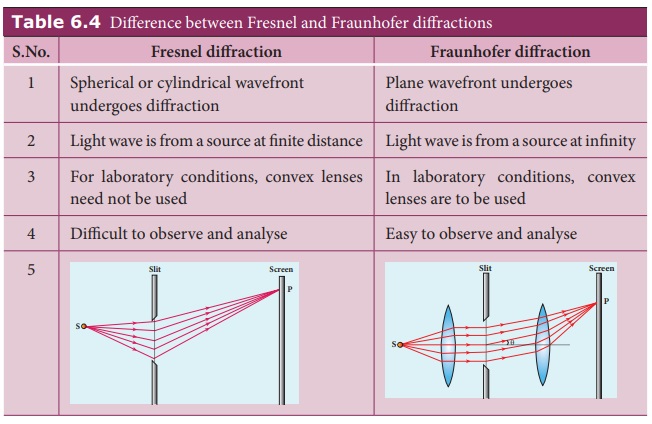
Fresnel diffraction
i.
Spherical or cylindrical wavefront undergoes diffraction
ii.
Light wave is from a source at finite distance
iii.
convex lenses need not be used in laboratory conditions
iv.
Difficult to observe and analyse
Fraunhofer diffraction
i.
Plane wavefront undergoes diffraction
ii.
Light wave is from a source at infinity
iii.
convex lenses are to be used in laboratory conditions
iv.
Easy to observe, and analyse
18. Discuss the special cases on first minimum in Fraunhofer diffraction.
The
equation for first minimum in single slit diffraction is, a sin ╬Ė = ╬╗ .
The
angular spread for its first minimum in the diffraction pattern is
Sin
╬Ė = ╬╗ / a
The
central maximum is found in between these first minima that occur on both the
sides.
Special cases:
i)
If a < ╬╗ , then sin ╬Ė > 1 which is not possible. Hence, diffraction does
not take place.
ii)
If a = ╬╗ , then sin ╬Ė =1 i.e. ╬Ė = 90┬░. The first minimum is at 90┬░. Hence, the
central maximum spreads fully into the geometrically shadowed region leading to
the bending of the diffracted light by 90┬░.
iii)
If a > ╬╗ and also comparable to ╬╗, say a = 2 ╬╗, then sin ╬Ė = 1/2 (or) ╬Ė = 30┬░. The diffraction is observed with
a measurable spread.
Hence,
it is concluded that for observing the diffraction pattern, essentially the
width of the slit 'a' must be just few times greater than the wavelength of
light ╬╗.
iv)
If a >> ╬╗, then sin ╬Ė < <
1 i.e. The first minimum falls within the width space of the slit itself.
Hence, the phenomenon of diffraction is not observed at all.
19. What is FresnelŌĆÖs distance? Obtain the equation for FresnelŌĆÖs distance.
Fresnel's
distance is the distance upto which ray
optics is obeyed and beyond which ray optics is not obeyed but, wave optics
becomes significant.
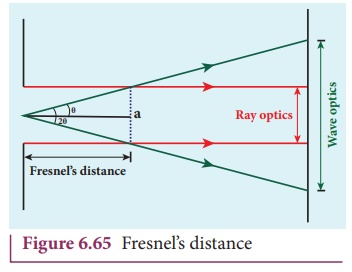
From
the diffraction equation for first minimum, sin ╬Ė = ╬╗/a ; ╬Ė = ╬╗/a
From the definition of Fresnel's distance, sin 2╬Ė = a/z ; 2╬Ė = a/z (or) ╬Ė = a/2z.
Equating
the above two equation gives, ╬╗/a = a/2z

After
rearranging, we get Fresnel's distance z as,
Z = a2 / 2╬╗
20. Mention the differences between interference and diffraction.
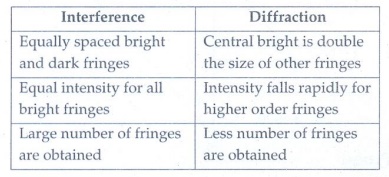
Interference
ŌĆó
Equally spaced bright and dark fringes
ŌĆó
Equal intensity for all bright fringes
ŌĆó
Large number of fringes are obtained
Diffraction
ŌĆó
Central bright is double the size of other fringes
ŌĆó
Intensity falls rapidly for higher order fringes
ŌĆó
Less number of fringes are obtained
21. What is a diffraction grating?
1)
Grating has multiple slits with equal widths of comparable size to the wavelength
of diffracting light.
2)
Grating is a plane sheet of transparent
material on which opaque rulings are made
3)
A modern commercial grating contains about 6000 lines per centimetre.
22. What is resolution?
Resolution
is measured by the smallest distance which could be seen clearly without the
blur due to diffraction.
23. What is RayleighŌĆÖs criterion?
According
to Rayleigh's criterion, for two point objects to be just resolved, the minimum
distance between their diffraction images must be in such a way that the
central maximum of one coincides with the first minimum of the other and vice
versa. The Rayleigh's criterion is said to be limit of resolution.
24. What is the difference between resolution and magnification?
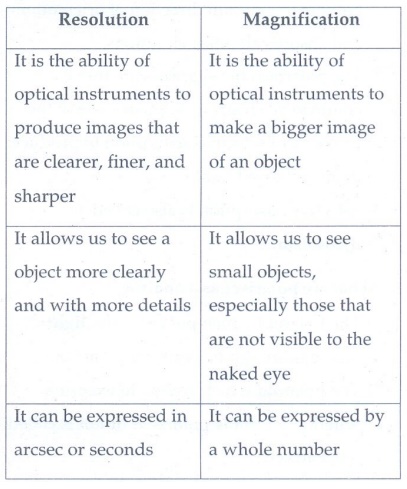
Resolution
ŌĆó
It is the ability of optical instruments to produce images that are clearer,
finer, and sharper
ŌĆó
It allows us to see a object more clearly and with more details
ŌĆó
It can be expressed in arcsec or seconds
Magnification
ŌĆó
It is the ability of optical instruments to make a bigger image of an object
ŌĆó
It allows us to see small objects, especially those that are not visible to the
naked eye
ŌĆó
It can be expressed by a whole number
25. What is polarisation?
The phenomenon of restricting the vibrations of light to a particular direction perpendicular to the direction of propagation of wave is called polarization of light.
26. Differentiate between polarised and unpolarised light
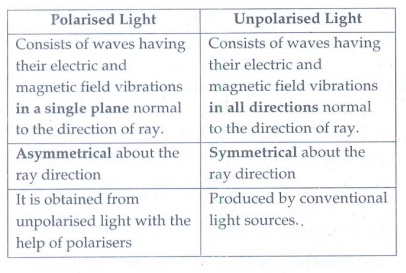
Polarised Light
ŌĆó
Consists of waves having their electric and magnetic field vibrations in a single plane normal to the
direction of ray.
ŌĆó
Asymmetrical about the ray direction
ŌĆó
it is obtained from unpolarised light with the help of polarisers
Unpolarised Light
ŌĆó
Consists of waves having their electric and magnetic field vibrations in all directions normal to the
direction of ray.
ŌĆó Symmetrical about
the ray direction
ŌĆó
Produced by conventional light sources.
27. Discuss polarisation by selective absorption.
1)
Selective absorption is the property of a material which transmits waves whose
electric field vibrations are in a plane parallel to a certain direction of
orientation and absorbs all other vibrations.
2)
The polaroids or polarisers are thin commercial sheets which make use of the
property of selective absorption to produce plane polarised light.
3)
Selective absorption is also called as dichroism.
28. What are polariser and analyser?
1)
The Polaroid which polarises the light
passing through it is called a polariser.
2)
The polaroid which is used to examine
whether a light is polarised or not is called an analyser.
29. What are plane polarised, unpolarised and partially polarised light?
1)
A light is said to be plane polarized if the intensity varies from
maximum to zero for every 90┬░ rotation of the analyser.
2)
If the intensity of light does not varies for rotation of the
analyser then the light is said to be unpolarised
light.
3)
If the intensity of light varies between
maximum and minimum (not zero) for
every 90┬░ rotation of the analyser, the light is said to be partially polarized light.
30. State and obtain MalusŌĆÖ law.
E.N
Malus discovered that when a beam of plane polarised light of intensity Io is incident on an
analyser, the intensity of light I transmitted from the analyser varies
directly as the square of the cosine of the angle ╬Ė between the transmission
axes of polariser and analyser. This is known as Malus' law.
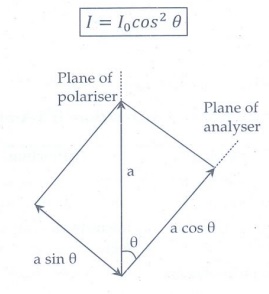
Proof:
1)
Consider the plane of polariser and analyser are inclined to each other at an
angle ╬Ė is as shown in Figure.
2)
Let Io be the intensity and a be the amplitude of the electric vector
transmitted by the polariser.
3)
The amplitude a of the incident light
has two rectangular components, (acos ╬Ė) and (asin ╬Ė) which are the parallel
and perpendicular components to the axis of transmission of the analyser.
4)
Only the component acos ╬Ė will be transmitted by the analyser.
5)
The intensity of light transmitted from the analyser is proportional to the
square of the component of the amplitude transmitted by the analyser.
I ŌłØ
(a cos ╬Ė)2
I = k (a cos ╬Ė)2
where
k is constant of proportionality.
I = ka2cos2╬Ė
I
= Iocos2 ╬Ė
Where,
I0
= ka2 is the maximum intensity of light transmitted through
the analyser.
The
following are few special cases.
Case (i) When ╬Ė =
0┬░, cos 0┬░= 1, I = Io
When
the transmission axis of polariser is
parallel to that of the analyser,
the intensity of light
transmitted from the analyser is equal
to the incident light that falls
on it from the polariser.
Case (ii) When ╬Ė =
90┬░, cos 90┬░ = 0, I = 0
When
the transmission axes of polariser and analyser are perpendicular to each other, the intensity of light transmitted from the analyser is zero.
31. List the uses of polaroids.
(i)
Polaroids are used in goggles and
cameras to avoid glare of light.
(ii)
Polaroids are used to take 3D pictures i.e., in holography.
(iii)
Polaroids are used to improve contrast
in old oil paintings.
(iv)
Polaroids are used in optical stress
analysis.
(v)
Polaroids are used as window glasses
to control the intensity of incoming light.
(vi)
Polarised laser beam acts as needle to
read/write in compact discs (CDs).
(vii)
Polarised light is used in liquid
crystal display (LCD).
32. State BrewsterŌĆÖs law.
Brewster's
law states that the tangent of the
polarising angle for a transparent medium is equal to its refractive
index.
tan ip = n
33. What is angle of polarisation and obtain the equation for angle of polarisation.
The
angle of incidence for which the reflected light is found to be plane polarised
is called polarizing angle or angle of polarization or Brewster's angle.
It is denoted by ip.
According
to Brewster's law
tan ip = n
Ōł┤ ip = tan-1(n)
34. Discuss about pile of plates.
ŌØ¢ Pile of plates makes use of
Brewster's law to convert the partially polarised refracted light into plane
polarised light.
ŌØ¢ It consists of several plates
kept one behind the other at an angle 90┬░ ŌłÆ ip with the horizontal
surface.
ŌØ¢ This arrangement ensures that
the parallel light falls on these plates at ip.
ŌØ¢ When this unpolarised light
passes successively through these plates, the few parallel vibrations to the
surface which may be present in the refracted light, get a chance for further
reflections at the succeeding plates.
ŌØ¢ Thus, both the reflected and the
refracted lights are found to be plane polarised.
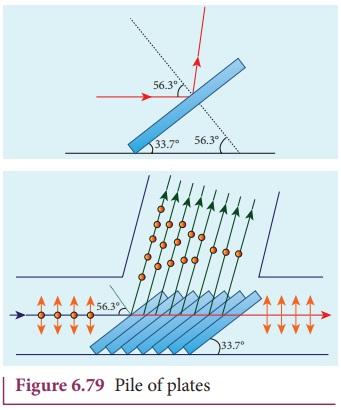
35. What is double refraction?
When
a ray of unpolarised light is incident on a calcite crystal, two refracted rays
are produced. Hence, two images of an object are formed. This phenomenon is
called double refraction (or)
birefringence.
36. Mention the types of optically active crystals with example.
ŌØ¢ Crystals like calcite, quartz,
tourmaline and ice which have only one optic axis are called uniaxial crystals.
ŌØ¢ Crystals like mica, topaz,
selenite and aragonite which have two optic axes are called biaxial crystals.
37. Discuss about Nicol prism.
Principle:
The
construction of a Nicol prism is based on the phenomenon of Double refraction.
Construction:
1)
Nicol prism is calcite crystal which
has a length three times is breadth
and angles are 72o and 108o.
2)
It is cut into two halves along the diagonal
3)
The two halves are pasted together with a layer of canada balsam, a transparent coment.
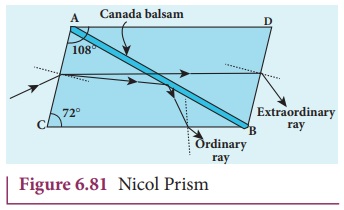
Working:
1)
Consider a ray of unpolarised light from monochromatic source is incident on
the Nicol prism.
2)
Double refraction takes place and the ray is split into ordinary and
extraordinary rays.
3)
They travel in different directions with different
velocities.
4)
For monochromatic sodium light the refractive index of the crystal for the
ordinary ray is 1.658 and for extraordinary
ray is 1.486. The refractive index of Canada
balsam is 1.523.
5)
The ordinary ray is total internally reflected at the layer of Canada balsam
and is prevented from emerging along with extraordinary ray.
6)
The extraordinary ray is transmitted
through the crystal which is plane
polarised.ŌĆā
38. How is polarisation of light obtained by scattering of light?
i)
When sun light gets scattered by the atmospheric molecules, the electrons of
these molecules are influenced by the vibrating components of the electric field
present in the sun light.
ii)
As the sunlight is unpolarised, it produces these vibrations in all directions.
iii)
These vibrating electrons radiate energy only in the direction perpendicular to
their vibrations.
iv)
When an observer views a beam of sunlight perpendicular to its direction of
travel, the radiations produced by the electrons vibrating in the direction
perpendicular to the direction of view will only reach the observer.
v)
Hence, the light reaching the observer is plane polarized.
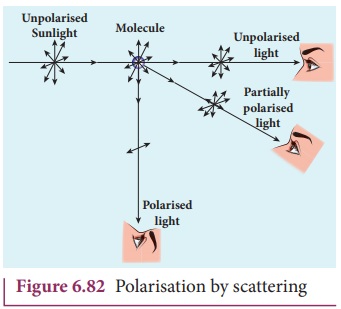
39. What are near point and normal focusing?
Near point focusing:
The
eye is least strained when image is formed at near point, ie. 25 cm
The
near point is also called as least distance of distinct vision.
Normal focusing:
The
eye is most relaxed when the image is formed at infinity. The focusing is
called normal focusing when the image is formed at infinity.
40. Why is oil immersed objective preferred in a microscope?
In
a microscope, smaller the value of dmin better will be the resolving
power.
To
reduce the value of dmin the optical path of the light is increased
by immersing the objective of the microscope into a bath containing oil of
refractive index n.
The
value of dmin decreases by 1/n
times. Hence, the resolving power is increases. Thus the oil immersed objective
is preferred in a microscope to increase the resolving power of the microscope.
41. What are the advantages and disadvantages of using a reflecting telescope?
Advantages:
Only
one surface it to be polished and maintained. Support can be given from the
entire back of the mirror whereas it is given only at the rim for lens. Mirrors
weigh much less compared to lens.
Disadvantages:
One obvious problem with a reflecting telescope is that the objective mirror would focus the light inside the telescope tube. One must have an eye piece inside obstructing some light.
42. What is the use of an erecting lens in a terrestrial telescope?
A
terrestrial telescope is used to see object at long distance on the surface of
earth. Hence, image should be erect.
Hence,
it has an additional erecting lens to
make the final image erect.
43. What is the use of collimator?
The collimator is used for producing a parallel beam of light.
44. What are the uses of spectrometer?
The
spectrometer is an optical instrument used to
analyze the spectra of different sources of light to measure the wavelength
of different colours and to measure the
refractive indices of materials
of prisms.
45. What is myopia? What is its remedy?
A
person suffering from nearsightedness or myopia cannot see distant objects clearly. This may be due to the short focal length of the eye lens (or)
larger diameter of the eyeball than
usual. This can be corrected using Concave
Lens.
46. What is hypermetropia? What is its remedy?
A
person suffering from farsightedness or hypermetropia or hyperopia cannot see closer object clearly. It occurs when the eye lens has long focal length or shortening of the
eyeball than usual. It can be corrected using Convex Lens.
47. What is astigmatism? What is its remedy?
Astigmatism
is the defect arising due to different curvatures
along different planes in the eye lens. Astigmatic person cannot see in all the directions equally
well. The defect due to astigmatism is more serious than myopia and
hypermetropia. The remedy to astigmatism is using a lens which has different curvatures in different planes i.e.
cyclindrical lenses.
48. What is presbyopia?
An
aged people cannot strain their eye more to reduce the focal length of the eye
lens. For clear vision, they should keep the object inconveniently away from
their eye. Thus, reading or viewing smaller things held in the hand is
difficult for them.
This
kind of farsightedness arising due to aging is called Presbyopia.
Related Topics